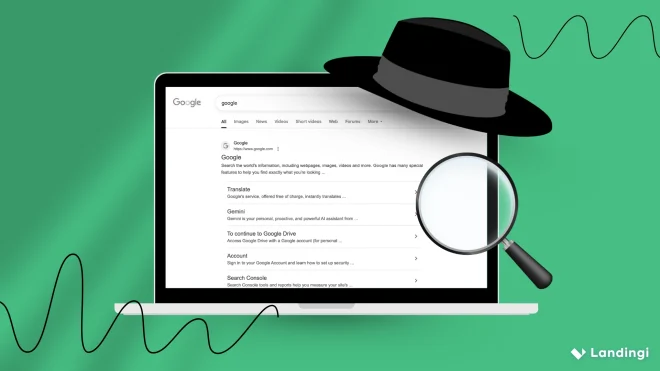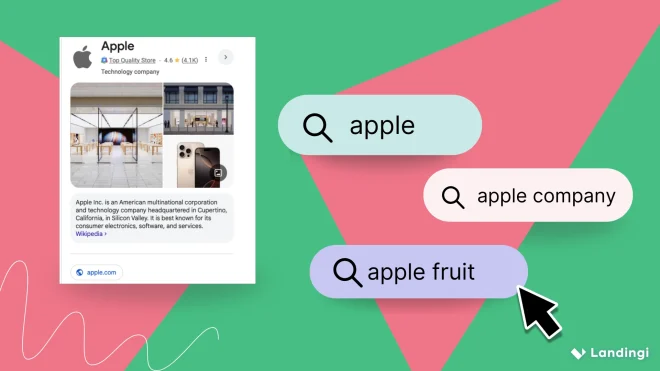White hat SEO is the practice of improving your website’s visibility in search engines by using only ethical methods that fully comply with Google’s guidelines.
White hat SEO is built for long-term results. It’s about creating relevant content, earning links naturally, keeping your site technically clean, and focusing on what users actually need. No shortcuts, no gray areas—just strategies that search engines and real people can trust. Google says it clearly in its Search Essentials: good SEO starts with helpful, people-first content that’s easy to access and understand.
Organic search still leads the way, driving over 53% of all website traffic, according to BrightEdge’s 2024 report. And the traffic you get through whitehat SEO doesn’t just show up—it performs. It stays longer, converts better, and doesn’t vanish with the next algorithm update. In this guide, we’ll break down why whitehat SEO works, how it actually functions, and how to improve your visibility without breaking the rules.

What Is Whitehat SEO in Google?
White hat SEO in Google means using ethical SEO practices that follow search engine guidelines—like creating relevant content, doing keyword research, and earning links naturally—to improve search engine rankings without risking penalties.
Whitehat SEO is all about helping users—not gaming the algorithm. It follows search engine guidelines and sticks to strategies that are built to last. That means focusing on what actually improves the user experience and adds real value.
Here are some examples of whitehat SEO techniques:
- Writing high-quality, original content
- Optimizing for mobile devices
- Improving page speed
- Adding internal links to support navigation and SEO
- Using clear and relevant meta titles and descriptions
- Structuring content with proper heading tags (H1, H2, H3…)
- Implementing schema markup to help search engines understand your content
- Compressing and optimizing images
- Improving accessibility (alt text, contrast, readability)
- Earning backlinks naturally through valuable, shareable content
Unlike blackhat tactics like keyword stuffing or link schemes, these methods don’t chase quick wins. Instead, they build trust, drive consistent organic traffic, and protect your site from penalties.
Use the drag-and-drop Landing Page Builder to create SEO-optimized pages in minutes—no dev help needed.
Why Is White Hat SEO Important?
Whitehat SEO is important because it keeps your site safe, visible, and trusted—while building long-term organic growth that actually benefits your users.
Chasing rankings with black hat SEO tactics might work for a minute… until it doesn’t. One algorithm update, and boom—your pages disappear from search engine results, and good luck getting back in.
Whitehat SEO keeps things simple. It plays fair, focuses on real value, and helps your site grow without getting burned by updates.
It also makes your users happy. Clean structure, fast load times, clear navigation—all the things Google (and real people) appreciate. And when your site delivers a good experience, you don’t just rank better. You build trust, get more clicks, and grow your brand without burning through ad budgets.
Use EventTracker to measure clicks, scrolls, and behavior that helps fine-tune SEO content and UX in real time
7 Easy Steps for Implementing and Improving White Hat SEO Methods
Whitehat SEO methods aren’t rocket science—they’re smart, structured steps that work when done right. Here’s how to do it without cutting corners or losing your mind:
1. Run a Full Website Audit
Start by checking what’s broken, slow, or missing. Fixing these issues is the foundation of all white hat SEO practices.
Example: Use a tool like Ahrefs or SE Ranking to scan your site for 404s, duplicate content, or missing meta descriptions. If your blog has 10 broken internal links—fix them. That’s instant SEO cleanup.

2. Simplify Your Site Structure
Make sure important pages are easy to reach—for users and for search engine crawlers. The fewer clicks it takes, the better.
Example: Your product page shouldn’t be buried under five dropdowns. Keep it within three clicks from the homepage. Bonus: that also helps Googlebot understand your site better.
3. Improve Your Page Speed
A slow site kills rankings and conversions. Speed is a key part of technical SEO and user experience.
Example: Run your homepage through PageSpeed Insights. If you score under 80, start with compressing images and enabling lazy loading. Swap your 2MB hero image for a WebP version and watch the load time drop.

4. Do Smart Keyword Research (And Actually Match Search Intent)
Don’t just grab keywords—understand what users really want when they type them in. Then create content that gives them exactly that.
Example: If “best standing desks” shows mostly product reviews, don’t write a general blog post. Write a comparison article with real pros/cons and affiliate links—just like the top 5 pages already ranking.
5. Build Topic Clusters, Not Random Posts
Whitehat SEO focuses on depth, not just keywords. Organize your content around core themes using topic clusters.
Example: Targeting “email marketing”? Create a pillar page, then link to supporting pages like “email subject lines,” “best email tools,” and “email A/B testing.” That builds authority and keeps users on your site.
6. Follow Google’s Rules
Don’t roll the dice with black hat SEO tactics. Google will catch it eventually. Stick to SEO whitehat techniques that are safe and effective.
Example: Skip paid link schemes. Instead, try broken link building: find a dead link on a blog in your niche, create better content, and suggest they replace it with your page.
7. Refresh and Enrich Your Content Often
Content isn’t “one and done.” Keep it updated, useful, and engaging with images, videos, and new data.
Example: That blog post you wrote in 2021? Update it with 2024 stats, add a short explainer video, and swap in a FAQ section to hit voice search queries.
Should I Implement White Hat SEO Methods?
Yes—if you want long-term results without the constant fear of getting wiped from search engine results overnight.
White hat SEO methods are the smart choice for anyone building a serious online presence. Whether you run an ecommerce store, a B2B site, or a content-driven blog, following ethical SEO practices helps you grow steadily, without risking sudden drops in search rankings.
It also gives you more control. Instead of constantly reacting to algorithm updates or cleaning up spammy backlinks, you focus on things that actually move the needle—like improving technical SEO, creating valuable content, or aligning with your target audience’s search intent.
If your traffic matters to your business, going white hat isn’t just safer—it’s more efficient in the long run.
How to Choose Best White Hat SEO Services?
To choose the best whitehat SEO services, start by checking if the provider actually follows what search engines recommend.
Look for services that focus on high-quality content, real keyword research, clean technical setup, and natural link building. Avoid any agency that buys links, uses keyword stuffing, or promises results that sound too good to be true—those are classic signs of black hat SEO tactics.
Red flag: If an agency guarantees #1 rankings in a fixed timeframe, run. No one can promise that—not even Google employees.
Strong services will be transparent about their work. You should see regular reports showing your keyword positions, organic traffic trends, and what’s being optimized each month. If they’re vague or won’t explain their methods, skip them.
Good white hat SEO is never one-size-fits-all. The right provider will build a strategy around your business, your audience, and your goals. That includes choosing the right target keywords, matching content to search intent, and improving your site’s structure and speed.
Check how they handle content, too. If their blog posts feel generic or thin, that’s another red flag. You want relevant content that answers real questions, builds trust, and earns organic links over time.
How to Become White Hat SEO Expert?
To become a whitehat SEO expert, start by understanding how search engines work—and what they expect from websites. Learn the basics of search engine optimization, from keyword research and on-page SEO to site structure and technical audits. Get comfortable with tools like Google Search Console, Ahrefs, or Semrush, and focus on strategies that align with search engine guidelines, not shortcuts.
Then practice.
A lot.
Work on real sites, test what improves search engine rankings, and pay attention to how updates affect search results. The more hands-on experience you get with ethical SEO practices—like creating quality content, improving page speed, and earning natural backlinks—the better. White hat SEO is less about gaming algorithms and more about giving users what they came for. The sooner you embrace that, the faster you’ll grow.
Pick from 400+ SEO-friendly templates that match your niche and intent—built to rank and convert.
What Is the Difference Between White Hat and Grey Hat SEO?
The main difference between whitehat and greyhat SEO is how closely they follow search engine guidelines—and how much risk they carry.
Whitehat SEO sticks to ethical, approved methods like creating valuable content, using relevant keywords naturally, and earning backlinks through trust, not tricks. It’s safe, sustainable, and built to last, even if it takes longer to see big results.
Greyhat SEO operates in a gray area—technically not breaking the rules, but definitely bending them. Think automated content, light keyword stuffing, or buying links from sketchy sites. These tactics can bring quick wins, but they come with a serious risk: if search engines update their rules or catch on, your rankings could tank overnight.
| Whitehat SEO | Greyhat SEO |
|---|---|
| Follows search engine guidelines | Bends the rules, but doesn’t outright break them |
| Focuses on valuable, user-first content | May use automated or lower-quality content |
| Uses keywords naturally | May overuse keywords for faster gains |
| Earns backlinks through trust | May buy links or use questionable link sources |
| Slow but steady growth | Faster results, but higher risk |
| Safe from penalties | Risk of getting flagged or penalized later |
| Long-term strategy | Short-term wins with potential downsides |
What Is the Difference Between White Hat and Black Hat SEO?
The difference between whitehat and blackhat SEO comes down to how they achieve rankings—and whether they play by the rules or try to cheat the system.
Whitehat SEO follows search engine guidelines closely. It’s about creating relevant content, improving technical SEO, earning natural links, and delivering a great user experience. These are safe, ethical SEO practices that lead to steady growth and long-term visibility.
Blackhat SEO does the opposite. It tries to manipulate search engine rankings through shortcuts like keyword stuffing, cloaking, buying links, or using private link networks. These blackhat SEO tactics might bring quick wins, but they’re risky and often lead to penalties or being removed from search engine results entirely.
Here’s how they compare:
Using whitehat SEO builds trust—with both users and search engines. Blackhat SEO might work short term, but it’s a high-stakes game with consequences that often outweigh the gains.
| Whitehat SEO | Blackhat SEO |
|---|---|
| Follows search engine rules | Breaks the rules to gain fast results |
| Focuses on relevant, helpful content | Uses low-quality or misleading content |
| Builds natural backlinks | Buys links or uses private link networks |
| Optimizes for users and long-term growth | Focuses only on rankings, not user experience |
| Safe and sustainable | Risky and often leads to penalties |
| Improves technical SEO fairly | May use tactics like cloaking or hidden text |
| Builds trust with search engines | Damages credibility and risks being deindexed |
What Is the Best White Hat SEO Tool?
The best whitehat SEO tool for most professionals is Ahrefs—thanks to its all-in-one toolkit built around clean, ethical SEO practices.
It’s great for finding relevant keywords, analyzing what your competitors rank for, and spotting backlink opportunities you can actually earn. The interface is clean, the data’s reliable, and features like intent-based keyword labels make planning content a lot easier. It’s especially strong if you’re focused on organic traffic and want to improve search rankings the smart, sustainable way.
The only downside? It’s on the pricey side. But if you’re serious about SEO and want to stick to what works (and what’s allowed), Ahrefs is worth it.
What Is the Role of Landing Pages in White Hat SEO?
Landing pages in whitehat SEO are built to match search intent with precision. Each one is focused on a specific topic or keyword, answering a clear need without fluff or distraction. Their jobis to deliver exactly what the user came for.
These pages help structure your site around intent clusters, which makes indexing easier and relevance stronger. When optimized right—fast load, mobile-friendly, focused copy—they do double duty: they rank well and convert well. There’s no over-optimization, no keyword stuffing—just clear value and a natural path to action.
In whitehat SEO, landing pages are where relevance, usability, and trust come together. Whether it’s local SEO, lead gen, or content targeting, they’re one of the most effective (and safe) ways to turn traffic into business.

What Are the Limitations of White Hat SEO?
The limitations of whitehat SEO include slower results, limited off-page shortcuts, and challenges with scaling content at speed.
Because it avoids tactics like link buying or keyword manipulation, whitehat SEO takes longer to show progress. Earning backlinks naturally and creating valuable content is time-intensive, especially in niches where competitors use riskier methods to rank faster. It also requires more resources to maintain consistency and quality as you grow. Still, these trade-offs are often worth it for anyone looking to build lasting authority without worrying about penalties.
Start for free and see how fast you can build landing pages that rank.
Use White Hat SEO to Improve Traffic on Your Landing Pages
Whitehat SEO is one of the most effective ways to drive consistent, high-quality traffic to your landing pages—without risking penalties or relying on paid ads. By focusing on what users actually need, and making sure each page meets that need clearly and quickly, you set your site up for long-term visibility and real business results.
At Landingi it is easier to put those whitehat strategies into action. You can build SEO-friendly landing pages in minutes—no coding needed. Each page is easy to optimize, fast-loading, and mobile-ready right out of the box. With built-in tools for A/B testing, tracking and powerful integrations, you can fine-tune your pages based on real data.
Want traffic that sticks? Build pages that deserve to rank. And if you’re ready to start, Landingi’s platform gives you everything you need to do it the right way. Try now!






